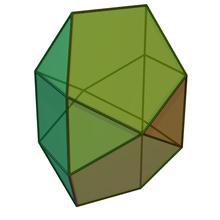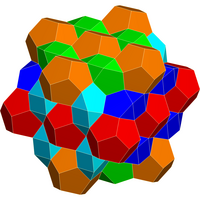| Bilunabirotunda | |
|---|---|
 | |
| Type | Johnson J90 – J91 – J92 |
| Faces | 8 triangles 2 squares 4 pentagons |
| Edges | 26 |
| Vertices | 14 |
| Vertex configuration | 4(3.5) 8(3.4.3.5) 2(3.5.3.5) |
| Symmetry group | |
| Properties | convex, elementary |
| Net | |
 | |

In geometry, the bilunabirotunda is a Johnson solid with faces of 8 equilateral triangles, 2 squares, and 4 regular pentagons.
Properties
The bilunabirotunda is named from the prefix lune, meaning a figure featuring two triangles adjacent to opposite sides of a square. Therefore, the faces of a bilunabirotunda possess 8 equilateral triangles, 2 squares, and 4 regular pentagons as it faces. It is one of the Johnson solids—a convex polyhedron in which all of the faces are regular polygon—enumerated as 91st Johnson solid . It is known as the elementary polyhedron, meaning that it cannot be separated by a plane into two small regular-faced polyhedra.
The surface area of a bilunabirotunda with edge length is: and the volume of a bilunabirotunda is:
Cartesian coordinates
One way to construct a bilunabirotunda with edge length is by union of the orbits of the coordinates under the group's action (of order 8) generated by reflections about coordinate planes.
Applications
Reynolds (2004) discusses the bilunabirotunda as a shape that could be used in architecture.
Related polyhedra and honeycombs
Further information: Regular_dodecahedron § Space_filling_with_cube_and_bilunabirotundaSix bilunabirotundae can be augmented around a cube with pyritohedral symmetry. B. M. Stewart labeled this six-bilunabirotunda model as 6J91(P4). Such clusters combine with regular dodecahedra to form a space-filling honeycomb.

|
 Spacefilling honeycomb |
 6 bilunabirotundae around a cube |
12 bilunabirotundae around a dodecahedron |
References
- ^ Berman, M. (1971). "Regular-faced convex polyhedra". Journal of the Franklin Institute. 291 (5): 329–352. doi:10.1016/0016-0032(71)90071-8. MR 0290245.
- Francis, D. (August 2013). "Johnson solids & their acronyms". Word Ways. 46 (3): 177.
- Cromwell, P. R. (1997). Polyhedra. Cambridge University Press. p. 86–87, 89. ISBN 978-0-521-66405-9.
- Timofeenko, A. V. (2009). "The Non-Platonic and Non-Archimedean Noncomposite Polyhedra". Journal of Mathematical Sciences. 162 (5): 710–729. doi:10.1007/s10958-009-9655-0.
- Reynolds, M. A. (2004). "The Bilunabirotunda". Nexus Network Journal. 6: 43–47. doi:10.1007/s00004-004-0005-8.
- B. M. Stewart, Adventures Among the Toroids: A Study of Quasi-Convex, Aplanar, Tunneled Orientable Polyhedra of Positive Genus Having Regular Faces With Disjoint Interiors (1980) ISBN 978-0686119364, (page 127, 2nd ed.) polyhedron 6J91(P4).
External links
- Weisstein, Eric W., "Bilunabirotunda" ("Johnson solid") at MathWorld.
- Miracle Spacefilling (Dodecahedron&Cube&Johnson solid No.91)

 . It is known as the
. It is known as the  is:
is:
 and the volume of a bilunabirotunda is:
and the volume of a bilunabirotunda is:

 is by union of the orbits of the
is by union of the orbits of the  under the group's action (of order 8) generated by reflections about coordinate planes.
under the group's action (of order 8) generated by reflections about coordinate planes.